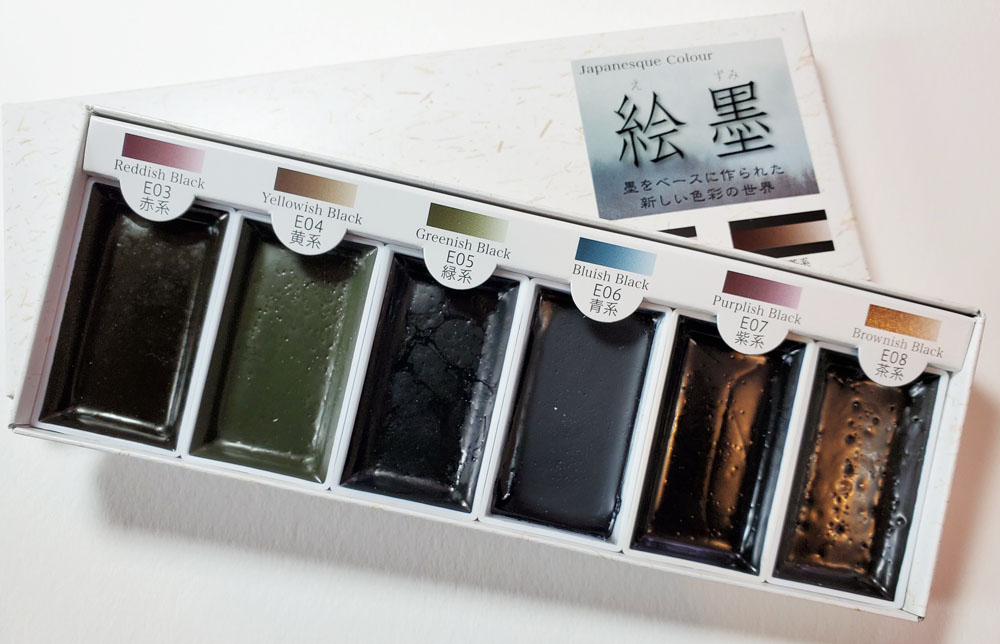Review by Tina Koyama
In late September as I geared up for InkTober, of course I inked up a few favorite fountain pens. But I also picked up a few new things to keep it fresh and challenging (you can see them in my inky previews here). One was a Boku-Undo E-Sumi Watercolor Palette (set of six $17; single colors $3 each). Since I fully embraced colored pencils, watercolors have not been in my regular sketching arsenal for years, so I thought these paints would be nothing more than a novelty. I was so wrong! They nearly took over my InkTober.

According to the product description, Boku-Undo colors are “made with a combination of traditional sumi ink* and colorful dyes.” The six “shadow black” shades in the palette are, indeed, mostly black with a hint of hue. They evoke the “off-black” shades of some gel pen inks. (Swatches below made in a Col-o-ring Oversize.)


One of the many challenges of using watercolors is that it’s difficult to get intense blacks and other dark hues, but these inky paints make it easy. I find it especially fun to make values studies with varying dilutions of color. (Still life below made with greenish-black on Canson XL 140 lb. watercolor paper.)

Seattle’s Smith Tower is one of my favorite buildings (and where my spouse guy and I were married a few decades back). I made this anniversary card with bluish-black (Canson XL 140 lb. watercolor paper).

For my daily InkTober sketches, I continued my series of hand drawings, and that’s when I really fell in love with Boku-Undo. Typically with watercolors, I get wimpy washes, but not with these – the washes are as rich and dark as I want them to be without much effort. I love pairing the inks with a Uni Posca Paint Marker with a brush tip for highlights. I used a notebook containing colored, coated pages that made the ink bead up – a surprising effect that I like! On the blue paper below, I used bluish-black. On the yellow page, I used reddish-black.


Perhaps my only problem with Boku-Undo is wondering what they really are. Traditional sumi is made of soot that comes in a solid form and must be slowly ground with water to make a liquid ink. It’s conveniently sold as a liquid ink, but I’m pretty sure traditional sumi masters would frown on using that. (Grinding your ink patiently and meditatively is part of the process, said my instructor at a workshop I once took. The workshop was only one day, and we must have spent half of it grinding the ink.) These Boku-Undo look and behave just like pan watercolors, so they aren’t traditional sumi, either . . are they painty inks or inky paints? No matter. Boku-Undo are a ton of fun.

*Editor’s Note: Sumi inks often contain carbon soot, pine tar and animal glues. These can be corrosive to dib pen nibs and other materials. DO NOT, under any circumstances, use Sumi inks in your fountain pens.
DISCLAIMER: Some items included in this review were provided free of charge by JetPens for the purpose of review. This review also includes affiliate links. The Well-Appointed Desk is a participant in the Amazon Services LLC Associates Program, an affiliate advertising program designed to provide a means for sites to earn advertising fees by advertising and linking to Amazon. Please see the About page for more details.
 Tina Koyama is an urban sketcher in Seattle. Her blog is Fueled by Clouds & Coffee, and you can follow her on Instagram as Miatagrrl.
Tina Koyama is an urban sketcher in Seattle. Her blog is Fueled by Clouds & Coffee, and you can follow her on Instagram as Miatagrrl.


Tell us more about this sketchbook!